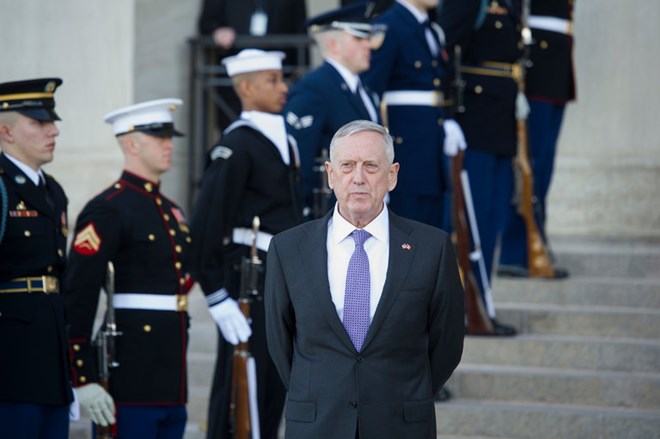
Thursday April 6, 2017
By Helene Cooper
 Defense Secretary Jim Mattis will have more independence in decision-making on military matters under President Trump than his predecessors had under President Barack Obama. Credit Cliff Owen/Associated Press
Defense Secretary Jim Mattis will have more independence in decision-making on military matters under President Trump than his predecessors had under President Barack Obama. Credit Cliff Owen/Associated Press
WASHINGTON – President Donald Trump has let the military know that the buck stops with them, not him. The Pentagon, after eight years of chafing at what many generals viewed as micromanaging from the Obama White House, is so far embracing its new freedom.
Officials say that much of Defense Secretary Jim Mattis' plan to defeat the Islamic State in Iraq and Syria, which Mattis delivered to the White House in February but has yet to make public, consists of proposals for speeding up decisionmaking to allow the military to move more quickly on raids, airstrikes, bombing missions and arming allies in Iraq, Syria and elsewhere. Commanders argue that loosening restrictions — as Trump has already done for U.S. operations in much of Somalia and parts of Yemen — could lead to a faster defeat of ISIS in the Middle East and the Horn of Africa.
"They explained what they wanted to do, the generals, who are very respected," Trump said after the raid. "And they lost Ryan."
Beyond that, many foreign policy experts point out that giving the military freedom over short-term tactics means little without a long-term strategy for the region, including what will happen after ISIS is routed, as the Pentagon expects, from Iraq and Syria.
"Moving decisionmaking on small tactical issues from the White House to commanders in the field is positive, but commanders' autonomy doesn't help accomplish strategic goals," said Jon B. Alterman, director of the Middle East Program for the Center for Strategic and International Studies.
During the Obama administration, the military had to follow standards set by the president in 2013 to carry out airstrikes or ground raids in countries like Somalia, where the U.S. was not officially at war. Those rules required that a target had to pose a threat to Americans and that there be near certainty that no civilian bystanders would die. Under the Trump administration's new rules, some civilian deaths are now permitted in much of Somalia and parts of Yemen if regional U.S. commanders deem the military action necessary and proportionate.
The Obama administration process frustrated many in the military.
First there was the initial proposal from the Pentagon. From there it went to a policy coordinating committee, composed of lower-level officials from the Pentagon, State Department and White House.
If the proposal cleared the policy committee, it then went to the National Security Council's deputies committee, composed of middle-level White House, State Department and Pentagon staff members, who in turn decided if they would kick it up to their Cabinet-level bosses, among them President Barack Obama's national security adviser, Susan Rice.
Finally, the full National Security Council — with the president in attendance — met on the proposal. At that point, Obama often had his own questions. "We had limiting principles that applied to everything," recalled Ben Rhodes, Obama's deputy national security adviser. "What were the risks to civilians on the ground? American service members? Overall national security interests?"
In the Trump administration, so far there have been few, if any, meetings of the policy coordinating committee, in large part because there are still vacancies across the government. Lt. Gen. H.R. McMaster, the national security adviser, is still building up his staff after Trump's first national security adviser, Michael Flynn, was fired in February.
Other analysts say Trump's new command style is already coming into focus. "Obama was cautious, he was analytical, he always wanted to see all the sides of the story before he took any action — possibly to a fault," said David Rothkopf, chief executive and editor of the Foreign Policy Group. "I think Trump is the opposite of all those things. Also to a fault."